Class of 1935
Commanding Officer, 2d Battalion,
2d Marines, 2d Marine Division FMF Pacific
During the landing on Tawawa, Amey was mortally wounded by hostile machine gun fire before reaching the shore.
The Pennsylvania Military College Legends represent the threads of the fabric that bind us to PMC. Because the fabric is strong, our bond will always continue.
This page contains the stories of all legends in all categories with the most recently added article first. To read the articles of the specific categories within the Legends, please click on one of the sub-categories below.
Cadets and others who wish to share their experiences about PMC are welcome to contribute to this page. Visit the Contact page to send us your Legend.
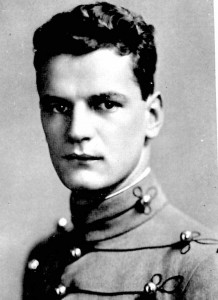
Class of 1935
Commanding Officer, 2d Battalion,
2d Marines, 2d Marine Division FMF Pacific
During the landing on Tawawa, Amey was mortally wounded by hostile machine gun fire before reaching the shore.
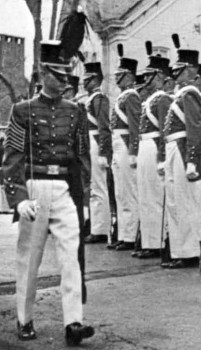 The Cadet Corps Commanders, called First Captains after Eisenhower’s 1963 visit, were the highest-ranking Cadet. They were the personification of the PMC Cadet. In the eyes of Rooks, they were “God-like figures.” To the Upper Classmen, they were responsible for maintaining the morale and standards of the Corps as well as keeping the bond of trust with the Military Staff.
The Cadet Corps Commanders, called First Captains after Eisenhower’s 1963 visit, were the highest-ranking Cadet. They were the personification of the PMC Cadet. In the eyes of Rooks, they were “God-like figures.” To the Upper Classmen, they were responsible for maintaining the morale and standards of the Corps as well as keeping the bond of trust with the Military Staff.
A selection committee, consisting of the Military Staff was responsible for selecting the new First Captain. This group prepared a slate of candidates and, after a series of meetings, the leadership of the Corps was decided and presented to the President of PMC.
The criteria for selecting a new First Captain consisted of:
1. A Cadet’s performance during ROTC Summer Camp
2. The military record of the Cadet at PMC
3. Academic Standing (a GPA of 2.5 was required)
4. Demonstrated, or potential, leadership qualities
Leadership, however, was the critical factor that was often considered the most important.
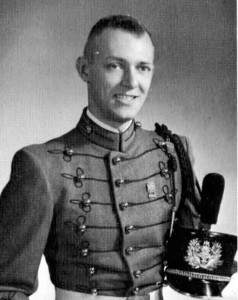 Walter Reasor attended the Perkiomen School and became interested in all things military. This brought him to PMC. As a talented drummer, he became an integral part of HQ Company (the PMC Marching and Concert Band), which was his first passion. Walt was the Tenor Drum Section Head of the PMC Band’s Drum Line. In one traditional PMC Halloween (anything goes) Parade, Section Head Reasor had the Tenor Drummers wear tartan bathrobes (as makeshift kilts), Full Dress Alfa multi-brass-buttoned Cadet jackets, and Cadet overseas caps modified with Cadet neckties (as cap tails) as quasi-Pipe and Drum Band uniforms. He received high marks for his creativity that evening. Cadet Reasor met Elizabeth Carol Fry at a church social at the end of his 4th Class (Freshman year). From that meeting he became a member of the “Elizabeth Carol Fry Fraternity” and spent most of his time at PMC with her and, subsequently, twenty-five years of marriage. As a Cadet, the members of HQ Company considered him to be a man who took “Duty, Honor and Country” seriously.
Walter Reasor attended the Perkiomen School and became interested in all things military. This brought him to PMC. As a talented drummer, he became an integral part of HQ Company (the PMC Marching and Concert Band), which was his first passion. Walt was the Tenor Drum Section Head of the PMC Band’s Drum Line. In one traditional PMC Halloween (anything goes) Parade, Section Head Reasor had the Tenor Drummers wear tartan bathrobes (as makeshift kilts), Full Dress Alfa multi-brass-buttoned Cadet jackets, and Cadet overseas caps modified with Cadet neckties (as cap tails) as quasi-Pipe and Drum Band uniforms. He received high marks for his creativity that evening. Cadet Reasor met Elizabeth Carol Fry at a church social at the end of his 4th Class (Freshman year). From that meeting he became a member of the “Elizabeth Carol Fry Fraternity” and spent most of his time at PMC with her and, subsequently, twenty-five years of marriage. As a Cadet, the members of HQ Company considered him to be a man who took “Duty, Honor and Country” seriously.
After his graduation in 1964, LT Reasor joined the 197th Infantry Brigade and was then assigned to an experimental program where he did not go to basic training and was immediately assigned to the 3rd Armor Division in Germany. In 1967, he assumed command of F Company, an independent tank company. He converted this unit to H Troop, 17th Cavalry, which then was assigned to the 198th Infantry Brigade. The 198th Brigade was subsequently deployed to Vietnam and assigned to the Chu Lai area of operations. The AO was located 56 miles south of Da Nang. Its assignment was to conduct “Search and Destroy” missions. This was a region of dried open rice paddies and considered to be controlled by the Viet Cong. Specialist Michael George wrote that H Troop would rarely see the enemy, but knew they could be anywhere to ambush them.
On the evening of 26 May 1968, five armored assault vehicles of H Troop, 17th Cavalry, were bivouacked and arrayed in their night defensive perimeter. That evening, the Viet Cong began a rocket attack against the brigade and commenced a ground assault of H Troop. Captain Reasor’s unit engaged the Viet Cong with automatic weapons fire. The Viet Cong then responded by attacking H Troop’s night perimeter with small arms and anti-tank weapons. Almost immediately, one Troop vehicle exploded from a direct hit. Captain Reasor immediately left his Command vehicle and rushed to aid the wounded. He then climbed atop of crippled track, repaired a damaged 50-caliber machine gun and used it to return suppressing fire. Once the attack has been repelled and the wounded air lifted to safety, Captain Reasor organized H Troop into a blocking position. For his “Extraordinary Heroism in Close Combat against two Hostile Forces,” Captain Reasor was awarded the Silver Star Medal.
Captain Reasor’s final assignment was as an ROTC instructor at PMC in 1969. Although involved in student life, as the end of the Corps approached, he became disillusioned with changes in the school and resigned. In the early 1990’s, he succumbed to a terrible disease that may have been caused by exposure to Agent Orange.
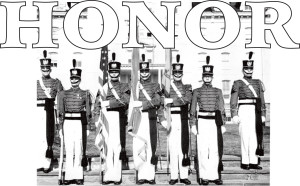 Theodore Hyatt modeled PMC after West Point. Colonel Charles Hyatt often called PMC the “West Point of the Keystone State.” Wherever possible, the rules and regulations of West Point were adopted for use at PMC. This made the Regulation Book the single most important book and influence on a PMC Cadet. Stated in the Regulation Book for PMC Cadets was the requirement that the PMC Cadet “is always gentlemanly in his conduct, and is possessed of a sense of personal responsibility and self-confidence.” Indeed, the related principles of “gentlemanly honor and moral obligation” were crucially important lessons to be embraced by all cadets throughout their cadet-years.
Theodore Hyatt modeled PMC after West Point. Colonel Charles Hyatt often called PMC the “West Point of the Keystone State.” Wherever possible, the rules and regulations of West Point were adopted for use at PMC. This made the Regulation Book the single most important book and influence on a PMC Cadet. Stated in the Regulation Book for PMC Cadets was the requirement that the PMC Cadet “is always gentlemanly in his conduct, and is possessed of a sense of personal responsibility and self-confidence.” Indeed, the related principles of “gentlemanly honor and moral obligation” were crucially important lessons to be embraced by all cadets throughout their cadet-years.
Colonel Frank K. Hyatt became President and Commandant of Cadets in 1930 and, for the next two decades, he faced numerous societal-changes as well as World War II. Col. Hyatt responded by making significant changes in the regulations that greatly altered the life of a Cadet. He firmly believed, however, that “gentlemanly conduct” was synonymous with the Cadet life-style and, frequently spoke of his belief that gentlemanly conduct (character) was an underlying principle through this quote that he repeated often and was also posted prominently in the Cadet Auditorium:
“When wealth is lost, nothing is lost;
When health is lost, something is lost;
When character is lost all is lost.”
In 1947, Col. Hyatt announced a liberalization of cadet privileges. In a newspaper article in the Chester Times, he explained “We have felt that some liberalization of our campus rules was necessary during the past several months. The new system of rules has been devised to meet new conditions and ideas.” Cadets were now allowed more time off campus and the boundaries where they were allowed to visit were expanded. Yet, Cadets were still not allowed to drink, smoke in public, and behave in an ungentlemanly fashion.
While Cadets welcomed these new liberalized privileges, they were still bound by their “honor” to obey the new rules. They were, furthermore, required to report any infractions or violations by other cadets. Violations of these privileges would be dealt with by a new organization, the Cadet Honor Court, which tried the violators and recommended punishment to Hyatt. The concept of “Gentlemanly Conduct and Honor” most certainly included character. The PMC Honor Code, however, may also be another example of PMC adopting the well known West Point canon “A Cadet will not lie, cheat, steal, or tolerate those who do” that was introduced by Douglas MacArthur in 1922.
The 1960’s brought changes to the cultural fabric of the nation and to PMC. During this time, acts of campus vandalism and theft were reported and civilian students sought to separate themselves from the Cadets. The social changes were exacerbated in 1966 by the creation of PMC Colleges, which were comprised two schools (PMC and Penn Morton (a non-military school)) on one campus. In addition, PMC instituted a formal “Honor Code” and Honor Board to reinforce the long-standing rules of “gentlemanly conduct” defined in the rules and regulations, which had governed the Cadets since 1821. This Honor Code continued until the Corps of Cadets were disbanded in 1972.
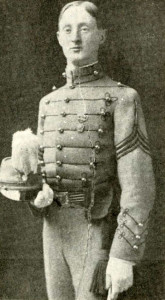 Burt Mustin, the son of Sadie and William Mustin of Pittsburgh, Pennsylvania, matriculated at Pennsylvania Military College in 1899 and, by his senior year, he was the Cadet Lieutenant of “D” Company, the catcher as well as the first baseman of the P.M.C. baseball team, the goalie of the PMC hockey team, and a talented vocalist with the PMC chorale-group. When the Merit List (Honor Roll) was announced in 1903, his 88.7 academic average placed him sixth in his class. He later recalled that he was a quick learner, especially with a staff-officer on-duty in each corridor who could “…pop in….” to his room at any moment to ensure that his nose was buried in his books.
Burt Mustin, the son of Sadie and William Mustin of Pittsburgh, Pennsylvania, matriculated at Pennsylvania Military College in 1899 and, by his senior year, he was the Cadet Lieutenant of “D” Company, the catcher as well as the first baseman of the P.M.C. baseball team, the goalie of the PMC hockey team, and a talented vocalist with the PMC chorale-group. When the Merit List (Honor Roll) was announced in 1903, his 88.7 academic average placed him sixth in his class. He later recalled that he was a quick learner, especially with a staff-officer on-duty in each corridor who could “…pop in….” to his room at any moment to ensure that his nose was buried in his books.
His classmate, Charles Spinney, kept dozens of photographs of young ladies that he knew in his hometown of Memphis, Tennessee, on the wall of his room and one day, while viewing ‘Spinney’s Gallery,’ Mustin remarked, “There’s the prettiest girl in the room.” Mustin later traveled to Memphis where he met and married Robina Woods, to whom he referred as his darling ‘Bine,’ in 1915.
His career at his father’s brokerage firm ended before it began due to an economic collapse and, for the next 25 years, Mustin was a car salesman. With the advent of World War II, automobile-production was halted in the United States. For a time he was a salesman for hearing aids. At age 60, Mustin and his wife moved to the warmer-climate of Tucson, Arizona, because of her failing-health. There he resumed his passion for acting by performing in an assortment of roles at local theaters.
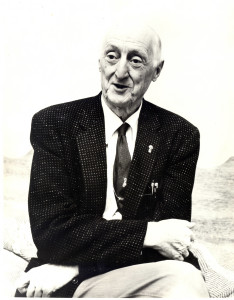 In 1951, Mustin was performing in a cameo role as “Willie,” the janitor, in Detective Story starring Kirk Douglas at the Sombrero Theater in Phoenix, Arizona. One night, William Wyler, a noted director, attended the play and was very impressed with Mustin’s performance as “Willie.” Wyler cast Mustin as “Willie” in Detective Story, together with fellow actor Kirk Douglas in the lead-role. Throughout his theatrical career, which spanned more than four decades, Mustin became a well known character actor who was noted for his dependability and versatility. Mustin appeared in more than 150 films and more than 400 television-productions, including roles as “Jud Crowley,” the barber shop patron, on The Andy Griffith Show, as “Gus,” the fireman, on Leave It To Beaver and as “The World’s Oldest Cat-Burglar” on Dragnet. He was a semi-frequent guest-star on the Dragnet television-series, both in the 1950’s and 1960’s, because he was a personal-friend of Jack Webb, the creator, director and producer of Dragnet. Mustin honored his alma mater by reprising his original (1951) film role as “Willie,” the janitor, in the theatre pmc student production of Detective Story in February 1970. Mustin’s campus visit was arranged by Cadet John E. N. Blair ’70, theatre pmc General Manager, who presented Mustin with a theatre pmc plaque and gray cadet-sweater following thunderous applause at the conclusion of the Opening Night performance of Detective Story, which was attended by numerous local dignitaries, including President and Mrs. Clarence R. Moll.
In 1951, Mustin was performing in a cameo role as “Willie,” the janitor, in Detective Story starring Kirk Douglas at the Sombrero Theater in Phoenix, Arizona. One night, William Wyler, a noted director, attended the play and was very impressed with Mustin’s performance as “Willie.” Wyler cast Mustin as “Willie” in Detective Story, together with fellow actor Kirk Douglas in the lead-role. Throughout his theatrical career, which spanned more than four decades, Mustin became a well known character actor who was noted for his dependability and versatility. Mustin appeared in more than 150 films and more than 400 television-productions, including roles as “Jud Crowley,” the barber shop patron, on The Andy Griffith Show, as “Gus,” the fireman, on Leave It To Beaver and as “The World’s Oldest Cat-Burglar” on Dragnet. He was a semi-frequent guest-star on the Dragnet television-series, both in the 1950’s and 1960’s, because he was a personal-friend of Jack Webb, the creator, director and producer of Dragnet. Mustin honored his alma mater by reprising his original (1951) film role as “Willie,” the janitor, in the theatre pmc student production of Detective Story in February 1970. Mustin’s campus visit was arranged by Cadet John E. N. Blair ’70, theatre pmc General Manager, who presented Mustin with a theatre pmc plaque and gray cadet-sweater following thunderous applause at the conclusion of the Opening Night performance of Detective Story, which was attended by numerous local dignitaries, including President and Mrs. Clarence R. Moll.
Throughout his entire life, Burt Mustin ’03 never swerved from his love of and loyalty to the PMC Corps of Cadets. Possibly, that ‘view’ was best expressed by General of the Army Douglas MacArthur who, during his final visit to his alma mater, the United States Military Academy, told the West Point Corps of Cadets, “As I cross the ‘River,’ my final-thoughts will be of The Corps, The Corps and The Corps. I bid you farewell!” It could be surmised that Burt Mustin had similar thoughts when he died on 28 January 1977.
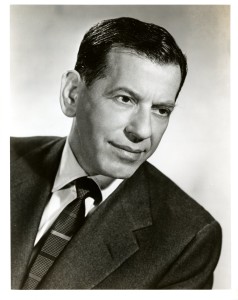 Emanuel (Manie, pronounced “Manny”) Sacks was a life long supporter and friend of PMC. His association with the school began in the 1918, when he enrolled in the Pennsylvania Military Preparatory School (PMPS). In 1920, he became a Cadet at PMC, Class of 1924. While at PMC he played football and became friendly with Hugh McCaffery ’24. He left PMC and began working at WCAU in Philadelphia. An avid supporter of PMC football, he arranged for WCAU to broadcast some PMC football games and military exercises. In June of 1955, this giant of the entertainment industry became a member of the PMC Board of Trustees. He had always taken an active interest in the school and its activities and this continued.
Emanuel (Manie, pronounced “Manny”) Sacks was a life long supporter and friend of PMC. His association with the school began in the 1918, when he enrolled in the Pennsylvania Military Preparatory School (PMPS). In 1920, he became a Cadet at PMC, Class of 1924. While at PMC he played football and became friendly with Hugh McCaffery ’24. He left PMC and began working at WCAU in Philadelphia. An avid supporter of PMC football, he arranged for WCAU to broadcast some PMC football games and military exercises. In June of 1955, this giant of the entertainment industry became a member of the PMC Board of Trustees. He had always taken an active interest in the school and its activities and this continued.
During his career at Columbia Records, RCA Victor and NBC Sacks gave encouragement and confidence to many artists. Although he kept out of the public eye, he worked closely with Jack Benny, George Burns, Edgar Bergen, Harry James, Dinah Shore and many others. In 1942, Sacks helped Frank Sinatra start his solo career. An appreciative Sinatra said during a 1959 CBS television tribute to Sacks that “There’s a little bit of Manie in everything good that has ever happened to me … Whenever I was in trouble and needed help, I yelled for Manie.” Despite Sacks’ reputation for his warm and charming personality, he was a tough bargainer according to RCA President David Sarnoff.
Sacks learned that he had leukemia when he was 52 years old, but only told his family and Sinatra. Upon learning of Sacks death, then Vice-President Moll, stated, “The College was deeply shocked to learn about his death, expressed the sentiments of the entire faculty, administration and student body of PMC. Manie Sacks, had made his mark in life as a top figure in the entertainment world, and we are going to miss a very influential friend.”
Watch Part 1 of Some of Manie’s Friends, a TV special which was broadcast in 1959. Perry Como, Dinah Shore, Eddie Fisher, Jane Wyman, Frank Sinatra and others are featured in the show.
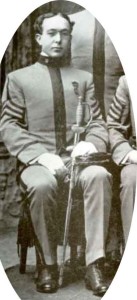 Charles Frederick Berthold Price was born in Germany of American parents. He and his parents returned to America when Price was six months old. His family settled in Wayne, PA. Price entered PMC in 1898. At PMC, he was a talented musician; particularly in his rendition of “Taps”. In his 2nd Class (Junior) Year, he was appointed Chief Musician, which meant he kept the PMC Bugle Corps in shape. As a First Classman (Senior), he commanded “B” Company as a Cadet Captain. The Porcupine Annual (then the PMC Yearbook) described Price as: “an advocate for the Extermination of Room Inspectors.” It was written that to avoid the “exertion” of making his bed every morning, he “nailed his sheets and blanket to the bed.” He slept on the floor with a spare blanket. Yet, his classmates considered him to be a “good fellow…and a kind officer.”
Charles Frederick Berthold Price was born in Germany of American parents. He and his parents returned to America when Price was six months old. His family settled in Wayne, PA. Price entered PMC in 1898. At PMC, he was a talented musician; particularly in his rendition of “Taps”. In his 2nd Class (Junior) Year, he was appointed Chief Musician, which meant he kept the PMC Bugle Corps in shape. As a First Classman (Senior), he commanded “B” Company as a Cadet Captain. The Porcupine Annual (then the PMC Yearbook) described Price as: “an advocate for the Extermination of Room Inspectors.” It was written that to avoid the “exertion” of making his bed every morning, he “nailed his sheets and blanket to the bed.” He slept on the floor with a spare blanket. Yet, his classmates considered him to be a “good fellow…and a kind officer.”
After graduation, Price was employed by the Pennsylvania Railroad and served in the Philadelphia City Cavalry of the Pennsylvania National Guard. In 1906, he was commissioned a Second Lieutenant in the Marine Corps and ordered to Annapolis for training. During the Spanish-American War, President Theodore Roosevelt ordered Price and a Marine Expeditionary Force to “protect American lives and property” in Cuba. Price remained there until 1908. He retuned to the U.S., but after a few months, he joined the Central American Expeditionary Force. Later deployments included: Panama during the construction of the Panama Canal; Vera Cruz during the Mexican Intervention in 1914; France, shortly before and after the armistice ending WWI; and Nicaragua. In 1935, he joined the Fourth Marines at the American Legation in Shanghai, China. Price was promoted to Brigadier General in 1940 and assumed command of the Department of the Pacific in 1941. After the Japanese attacked Pearl Harbor, he was promoted to Major General and placed in command of the Second Marine Division. He assumed command of the Defense Force, Samoan Group, in 1942. His assignment was to secure the approaches to Samoa Islands. His efforts in occupying and developing the U.S. presence on the Ellice Islands made the seizure of the Gilbert Islands possible, thereby opening the Central Pacific. For his ability, perseverance and tact he was awarded the Legion of Merit Medal with the Combat “V” for heroism during direct participation in combat operations by Admiral Chester W. Nimitz, Commander in Chief, Pacific Ocean Areas (CinCPOA), for U.S. and Allied air, land, and sea forces during World War II.
Price returned to the San Diego area in 1944. The following year he retired. He continued to live in the San Diego area until his death in 1954.
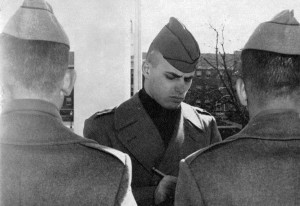 Every morning and evening the Corps of Cadets assembled along the curved driveway in front of Old Main. Before they saluted, rendering Honors to the Colors, Cadets anxiously awaited the call to “The Porch”. Throughout the Brigade you heard “First platoon, second squad, fifth man.” Each Cadet in that position would then hastily proceed to the Porch of Old Main and stand inspection. A First Classman (Senior) would slowly inspect each Cadet in great detail. Shoes had to be perfectly spit-shined. Brass needed to be polished and worn correctly. The gig-line was to be exact. Trousers and shirt pressed. Fingernails clean, trimmed and you had to have a good haircut. In addition, there would always be questions, such as: “Who are the members of the Joint Chiefs of Staff?” or “Name the Presidents of PMC”. These inspections and other aspects of life in the Corps were part of a rigorous 30-week company competition to become the Honor Company.
Every morning and evening the Corps of Cadets assembled along the curved driveway in front of Old Main. Before they saluted, rendering Honors to the Colors, Cadets anxiously awaited the call to “The Porch”. Throughout the Brigade you heard “First platoon, second squad, fifth man.” Each Cadet in that position would then hastily proceed to the Porch of Old Main and stand inspection. A First Classman (Senior) would slowly inspect each Cadet in great detail. Shoes had to be perfectly spit-shined. Brass needed to be polished and worn correctly. The gig-line was to be exact. Trousers and shirt pressed. Fingernails clean, trimmed and you had to have a good haircut. In addition, there would always be questions, such as: “Who are the members of the Joint Chiefs of Staff?” or “Name the Presidents of PMC”. These inspections and other aspects of life in the Corps were part of a rigorous 30-week company competition to become the Honor Company.
The final portions of the competition were held each spring. the companies of the Corps participated in a drill competition plus a contest to determine the Outstanding Cadet Sergeant, Cadet Corporal and Cadet Private. The drill competition to be Honor Company was rigorous. Each company was graded based on inspection, manual of arms and facing movements and marching movements. The outside judges assigned points for each company’s performance. Prior to the company drill, the contest to determine individual honors took place. Independent judges would evaluate each Cadet candidate and awarded points based on inspection, military knowledge and performance.
The Honor Company of the Year Award was presented at the annual Mother’s Day Parade. The Company that had demonstrated superior performance during the competition was recognized as the best of the Corps of Cadets. For many Cadets it was a significant and memorable achievement.
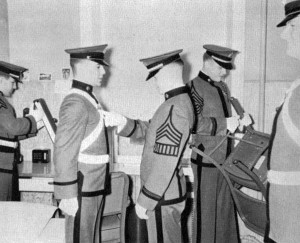 Fourth Classmen (Freshmen), also known as “Rooks,” arrived at PMC with little or no understanding of what they were starting. Their training began almost immediately. Starting in 1961, Rooks moved into Howell Hall, Cann Hall or Turrell Hall. As they did, the Cadre, those upperclassmen charged with Rook training, confronted them with a blizzard of instructions. As the Cadre walked the halls they bellowed instructions on how to organize each room. These now bewildered Rooks learned quickly.
Fourth Classmen (Freshmen), also known as “Rooks,” arrived at PMC with little or no understanding of what they were starting. Their training began almost immediately. Starting in 1961, Rooks moved into Howell Hall, Cann Hall or Turrell Hall. As they did, the Cadre, those upperclassmen charged with Rook training, confronted them with a blizzard of instructions. As the Cadre walked the halls they bellowed instructions on how to organize each room. These now bewildered Rooks learned quickly.
Each room was almost identical. Both the built-in locker and wall locker were to be shared. There were also two desks and bunk beds. Everything had a place and all items had to be displayed exactly as instructed in the “Fourth Class Handbook.” To ensure uniformity for those items that required folding, such as one’s underwear, Rooks were instructed to make cardboard rectangles so that the folded underwear were given a uniform and squared-off appearance. There were even instructions on how to hang items in the wall locker and display unused hangers (all hangers had to face the same direction with the rounded part of the hanger facing outward)! Imagine the look on the faces of Rooks when they learned that there were specific instructions that needed to be followed when putting away their belongings. Where were their mothers?
Throughout the week, daily room inspections were a part of the routine for Rooks. One of the most important items in a room was an index card stuck in the wall plate of the light switch. On this card were the names of the occupants. The card was reversible so that one name appeared at the top. That name was the room orderly for the week. It was the responsibility of the room orderly to keep the floor cleaned, trash emptied and room free of debris during the week. Roommates were responsible for their own belongings.
On Friday, Rooks prepared for the formal white glove inspection Saturday morning. Typically this was a time when Rooks had a chance to relax while they worked. They could walk the hallways in chinos and a t-shirt and were not required to brace or square corners. Rooks quickly learned that Saturday Morning Inspections required a great deal more than what was written in the Regulation Book. Floors were waxed and buffed. For many, learning how to use the unwieldy buffing machines was another new experience. Rooks also learned how to get a high polish on the floor by using a towel under the buffer. At some point during the evening you could find the shower full of Rooks standing with the covers from the heating elements. Brass uniforms buttons had to be cleaned. Windowsills cleaned, shades were placed at half-mast, desk items nearly arranged and the tops and bottoms of shoes cleaned. Saturday morning there was a last minute frenzy to ensure that your bed conformed to the regulations (the blanket needed to be folded 27 inches from the head with 18 inches of sheet exposed with the pillow placed squarely in the space). Of course the blanket needed to be taut enough so that a “quarter could bounce off it” and the hospital corners at the foot of the bed had to be exact. As the call echoed through the hall that the inspecting officers had entered the building, Rooks scrambled to take their positions in their room.
Eventually a loud knock on the door announced the arrival of the inspection team — all wearing white gloves. Standing at attention while inspectors gave each room a rigorous inspection, Rooks were amazed. Their room was clean enough to make any hospital proud. Yet rooms were declared, “Not fit for human habitation” because dirt or dust found on the top of a shoebox, the bottom of a lamp or even in the lamp socket after the bulb was removed. Many Rooks, however, found ways to lighten the situation. Some found spraying 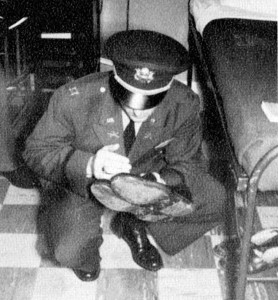 Pledge (spray wax) on the floor made for a very slippery floor and produced many giggles as the inspectors slid. Others doubled-cleaned everything, including the soles of their shoes. Using heel and sole enamel on the bottoms of the shoes was often a way of earning praise or better yet merits.
Pledge (spray wax) on the floor made for a very slippery floor and produced many giggles as the inspectors slid. Others doubled-cleaned everything, including the soles of their shoes. Using heel and sole enamel on the bottoms of the shoes was often a way of earning praise or better yet merits.
Inspectors were known to give an individual a merit or demerit for specific element of the inspection, such as hanging uniforms improperly. If a Rook accumulated enough demerits, they would find themselves marching Penalty Tours on the blacktop between Old Main and Memorial Stadium just below the Commandant’s Office.
These inspections involved all cadets, however, there were several larger purposes. Most important, they promoted teamwork, attention to detail, and a sense of camaraderie among cadets in each company. They also were a component of the 30-week Honor Company Competition. The company earning the best marks was announced each week, adding points toward the overall competition. Honor Company was announced during the Mother’s Day Parade in May and was recognized as the best in the Corps of Cadets.
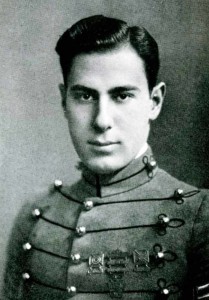 William Stern had failed several attempts at boarding schools. While his parents were traveling Europe, they happened to meet a Cadet from Pennsylvania Military College. Impressed by the young man’s poise and manners, the Sterns decided that PMC was the place for Bill to receive discipline and an education. Bill Stern flourished at PMC; he played basketball, football, and polo, used his extensive skills on the saxophone to help start a jazz group, led the college orchestra, and was appointed Captain Adjutant. Bill’s page in the Sabre and Sash, however, pointed to his future. “Is every body happy? This is Bill Stern speaking from the Bowl of Roses way out here in Lieperville.” Bill is a Graham McNamee, Ted Lewis, and a Frank Carideo all rolled up into one little bundle of vitality.”
William Stern had failed several attempts at boarding schools. While his parents were traveling Europe, they happened to meet a Cadet from Pennsylvania Military College. Impressed by the young man’s poise and manners, the Sterns decided that PMC was the place for Bill to receive discipline and an education. Bill Stern flourished at PMC; he played basketball, football, and polo, used his extensive skills on the saxophone to help start a jazz group, led the college orchestra, and was appointed Captain Adjutant. Bill’s page in the Sabre and Sash, however, pointed to his future. “Is every body happy? This is Bill Stern speaking from the Bowl of Roses way out here in Lieperville.” Bill is a Graham McNamee, Ted Lewis, and a Frank Carideo all rolled up into one little bundle of vitality.”
“For twenty years, Stern was a fixture in broadcasting, rising to become one of the most famous, successful, and recognizable announcers of his time. He hosted several shows, including Spotlight on Sports, Remember This Date, and the very popular Sports Newsreel, a prime-time radio show featuring sports stories, news, and interviews. Sports Newsreel was heard on NBC from October 1937 to September 1953, when it moved to ABC, ending in June 1956. He was the recipient of over 30 awards from various radio, movie, and television publications for broadcasting. These included: the Billboard poll 1948-1949, the Radio Mirror poll 1949, the Scripps Newspaper Award Contest for five consecutive years, the Hearst newspaper award for four consecutive years, and the Radio Daily poll for ten years. In addition, Motion Picture Daily’s annual radio poll announced Bill Stern as the ‘Best Sports Announcer’ in 1951 for the 13th consecutive year. Stern retired from broadcasting in 1956 after collapsing at a football game.”
“Bill Stern never forgot Pennsylvania Military College. He returned in 1944 to deliver a eulogy for the PMC cadets lost during World War II, addressed a PMC sports banquet in 1955 and narrated the film ‘The PMC Story’ in 1957. Bill Stern paid his highest tribute to the college in a letter to the PMC Alumni Bulletin in which he wrote, ‘Whatever I did, you can credit to PMC. I came there a young punk, and left a man. PMC taught me much, mainly that in this life you get what you put into it.’ “
On November 19, 1971, Bill Stern died of a heart attack at the age of 64. He was inducted into the National Sportswriters and Sportscasters Hall of Fame in March 1974 and the American Sportscasters Association Hall of Fame in 1984.
Reprinted with permission from the Widener University Archives.

Copyright © 2025 · Pennsylvania Military College Child Theme on Genesis Framework · WordPress · Log in